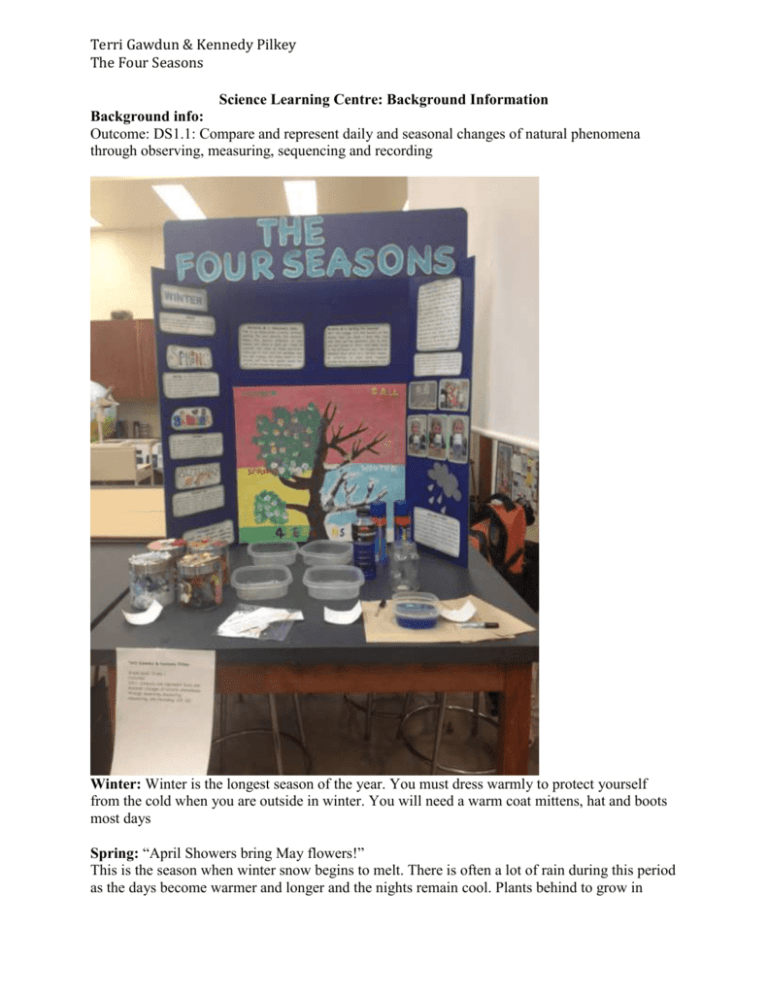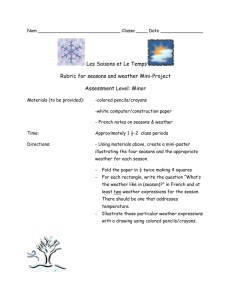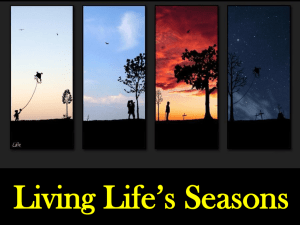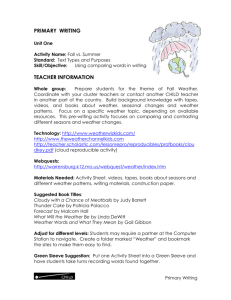Kennedy and Terri`s Science Centre
advertisement

Terri Gawdun & Kennedy Pilkey The Four Seasons Science Learning Centre: Background Information Background info: Outcome: DS1.1: Compare and represent daily and seasonal changes of natural phenomena through observing, measuring, sequencing and recording Winter: Winter is the longest season of the year. You must dress warmly to protect yourself from the cold when you are outside in winter. You will need a warm coat mittens, hat and boots most days Spring: “April Showers bring May flowers!” This is the season when winter snow begins to melt. There is often a lot of rain during this period as the days become warmer and longer and the nights remain cool. Plants behind to grow in Terri Gawdun & Kennedy Pilkey The Four Seasons spring. Trees remain bare until April or May. You will need a warm coat, and possibly a hat, mittens and boots during this season. An umbrella is also useful. Summer: Most areas experience mosquitos, and other insects such as bees, ladybugs, and butterflies, in late spring or early summer. Make sure you arrive with clothing for warm weather but also make sure to have a coat or sweater on hand for cooler days. Light clothes and sandals work best in the summer. It is wise to wear a hat and apply sunscreen to exposed skin to prevent sunburn Autumn: In the fall, typically the shortest of the seasons, days become noticeably shorter and the first frosts appear. Leaves in many parts of the country leaves turn from green to red, yellow and brown before they fall from the trees. You can expect the first snow in November. You will need a coat, mittens, hat, and boots as the end of fall arrives. Why does it rain? Warm air rises, and with it so does water droplets. These tiny drops rise if cold air blows in. Mountains can also make them rise which is why it rains a lot there. When the air holds lots of water droplets clouds forms. If a lot of water droplets gather in the clouds, the clouds become heavy. Gravity causes the water droplets to fall as rain when the clouds get too heavy and can’t hold more water Activity #1: Discovery Jars Materials: - 4 jars for each season - Stickers of seasonal items: snowmen, sun, etc. - Coloured pompoms - Glitter - Flowers - Leaves - Rocks - Blue glass rocks - Tri-coloured pasta Directions for discovery jars: This is an observation activity. Without opening the jars have students observe the inside contents to see the differences between seasons (colour, characteristics, holidays, etc.). Terri Gawdun & Kennedy Pilkey The Four Seasons Terri Gawdun & Kennedy Pilkey The Four Seasons Activity #2: Sorting the Seasons! Materials: - 4 containers labeled with the four seasons - 10 images that represent each season (40 in total) (images can include anything such as colours, activities done in certain seasons, Holidays, weather changes, etc.) Directions (for activity # 2): Have students sort the images into the four corresponding baskets based on what season it belongs to. Students may use the discovery jars to assist them. Activity #3: Making a Rain Cloud! Materials: - Small mason jars - Water - Shaving cream - Water/blue food coloring water mixture - Glass droppers rials: Directions: Fill the jar up to the line and put a layer of shaving cream on top the of the water to represent a cloud prior to the students starting the experiment. Instruct students to squeeze up the water/ food coloring mixture into the dropper and have students pour the dropper on top of the shaving cream. Have students keep repeating the process until “the cloud” gets too heavy with water that it starts to rain. Have students observe what is happening.









